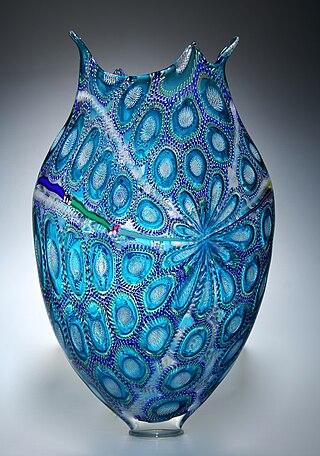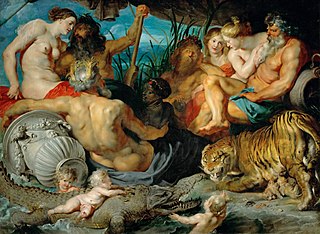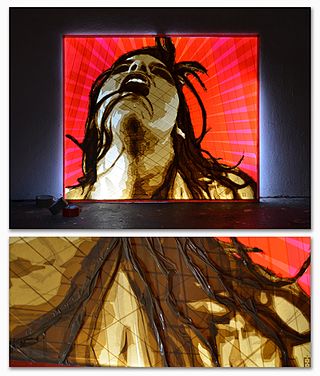The following outline is provided as an overview of and topical guide to sculpture:

Installation art is an artistic genre of three-dimensional works that are often site-specific and designed to transform the perception of a space. Generally, the term is applied to interior spaces, whereas exterior interventions are often called public art, land art or art intervention; however, the boundaries between these terms overlap.
Public art is art in any media whose form, function and meaning are created for the general public through a public process. It is a specific art genre with its own professional and critical discourse. Public art is visually and physically accessible to the public; it is installed in public space in both outdoor and indoor settings. Public art seeks to embody public or universal concepts rather than commercial, partisan, or personal concepts or interests. Notably, public art is also the direct or indirect product of a public process of creation, procurement, and/or maintenance.

Studio glass is the modern use of glass as an artistic medium to produce sculptures or three-dimensional artworks in the fine arts. The glass objects created are intended to make a sculptural or decorative statement, and typically serve no useful function. Though usage varies, the term is properly restricted to glass made as art in small workshops, typically with the personal involvement of the artist who designed the piece. This is in contrast to art glass, made by craftsmen in factories, and glass art, covering the whole range of glass with artistic interest made throughout history. Both art glass and studio glass originate in the 19th century, and the terms compare with studio pottery and art pottery, but in glass the term "studio glass" is mostly used for work made in the period beginning in the 1960s with a major revival in interest in artistic glassmaking.

Masking tape, also known as painter's tape, is a type of pressure-sensitive tape made of a thin and easy-to-tear paper, and an easily released pressure-sensitive adhesive. It is available in a variety of widths. It is used mainly in painting, to mask off areas that should not be painted.
A paint marker is a type of marker pen that is used to create permanent writing on a variety of surfaces such as paper, metal, stone, rubber, plastic, and glass.
Rebecca Horn is a German visual artist, who is best known for her installation art, film directing, and her body modifications such as Einhorn (Unicorn), a body-suit with a very large horn projecting vertically from the headpiece. She directed the films Der Eintänzer (1978), La ferdinanda: Sonate für eine Medici-Villa (1982) and Buster's Bedroom (1990). Horn presently lives and works in Paris and Berlin.

Anamorphosis is a distorted projection that requires the viewer to occupy a specific vantage point, use special devices, or both to view a recognizable image. It is used in painting, photography, sculpture and installation, toys, and film special effects. The word is derived from the Greek prefix ana-, meaning "back" or "again", and the word morphe, meaning "shape" or "form". Extreme anamorphosis has been used by artists to disguise caricatures, erotic and scatological scenes, and other furtive images from a casual spectator, while revealing an undistorted image to the knowledgeable viewer.

A work of art, artwork, art piece, piece of art or art object is an artistic creation of aesthetic value. Except for "work of art", which may be used of any work regarded as art in its widest sense, including works from literature and music, these terms apply principally to tangible, physical forms of visual art:

Jun Kaneko is a Japanese-born American ceramic artist known for creating large scale ceramic sculpture. Based out of a studio warehouse in Omaha, Nebraska, Kaneko primarily works in clay to explore the effects of repeated abstract surface motifs by using ceramic glaze.

Stencil graffiti is a form of graffiti that makes use of stencils made out of paper, cardboard, or other media to create an image or text that is easily reproducible. The desired design is cut out of the selected medium and then the image is transferred to a surface through the use of spray paint or roll-on paint.

Ducts are conduits or passages used in heating, ventilation, and air conditioning (HVAC) to deliver and remove air. The needed airflows include, for example, supply air, return air, and exhaust air. Ducts commonly also deliver ventilation air as part of the supply air. As such, air ducts are one method of ensuring acceptable indoor air quality as well as thermal comfort.

Mark Jenkins is an American artist who makes sculptural street installations. Jenkins' practice of street art is to use the "street as a stage" where his sculptures interact with the surrounding environment including passersby who unknowingly become actors. His installations often draw the attention of the police. His work has been described as whimsical, macabre, shocking and situationist. Jenkins cites Juan Muñoz as his initial inspiration.
Spray-Up also known as chop method of creating fiberglass objects by spraying short strands of glass out of a pneumatic gun. This method is used often when one side of the finished product is not seen, or when large quantities of a product must be made cheaply and quickly with moderate strength requirements. Corvette fenders and boat dinghies are commonly manufactured this way.

Modern sculpture is generally considered to have begun with the work of Auguste Rodin, who is seen as the progenitor of modern sculpture. While Rodin did not set out to rebel against the past, he created a new way of building his works. He "dissolved the hard outline of contemporary Neo-Greek academicism, and thereby created a vital synthesis of opacity and transparency, volume and void". Along with a few other artists in the late 19th century who experimented with new artistic visions in sculpture like Edgar Degas and Paul Gauguin, Rodin invented a radical new approach in the creation of sculpture. Modern sculpture, along with all modern art, "arose as part of Western society's attempt to come to terms with the urban, industrial and secular society that emerged during the nineteenth century".

Max Zorn is a Dutch-German artist who has been active in street art at night and urban art since May 2011. His style is notable for its use of brown packing tape as a medium and cutting on acrylic glass with a scalpel to create portraits that need lighting from behind to be seen.

DAIM is a German graffiti artist who lives and works in Hamburg. He is particularly known for his large-size, 3D-style graffiti works. This has become known as his trademark. For his technically sophisticated style he obtained the reputation of being one of the best graffiti artists in the world.

Slava "Ostap" Osinski is a street artist who creates works on acrylic glass using packing tape or duct tape and duct tape. He also produces work in live performances and also creates installation art works.


















